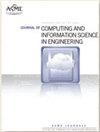Making Robotic Swarms Trustful: A Blockchain-Based Perspective
IF 2.6
3区 工程技术
Q2 COMPUTER SCIENCE, INTERDISCIPLINARY APPLICATIONS
Journal of Computing and Information Science in Engineering
Pub Date : 2023-04-17
DOI:10.1115/1.4062326
引用次数: 1
Abstract
Lately the importance of swarm robotics has been recognized in a wide range of areas, including logistics, surveillance, disaster management, agriculture, and other industrial applications. The swarm intelligence introduced by the existing paradigm of Artificial Intelligence and Machine Learning often ignores the aspect of providing security and reliability guarantees. Consider a futuristic scenario wherein self-driving cars will transport people, self-driving trucks will carry cargo between warehouses, and a combination of legged robots/drones will ship cargo from warehouses to doorsteps. In the case of such a heterogeneous swarm of robots, it is crucial to ensure a trustful and reliable operating platform for smooth coordination, collaborative decision-making via appropriate consensus, and seamless information sharing while ensuring data security. In this direction, blockchain has been proven to be an effective technology that maintains the transactions (records) in a trustful manner after being validated through consensus. This guarantees accountability, transparency, and trust concerning the storage, safeguarding, and sharing of information among the parties. In this paper, we provide a walkthrough demonstrating the feasibility of using blockchain technology to make the robotic swarm trustful systems in their adoption to critical applications at large-scale. We highlight the pros and cons of the use of cloud vis-a-vis blockchain in swarm robotics. Finally, we present various future research opportunities pertaining to the adoption of blockchain technology in swarm robotics applications.使机器人群可信:基于区块链的视角
最近,群体机器人的重要性在广泛的领域得到了认可,包括物流、监视、灾害管理、农业和其他工业应用。现有人工智能和机器学习范式引入的群体智能往往忽略了提供安全可靠保障的方面。设想一个未来的场景,自动驾驶汽车将运送人员,自动驾驶卡车将在仓库之间运送货物,有腿的机器人/无人机将把货物从仓库运送到家门口。在这种异构机器人群的情况下,在确保数据安全的同时,确保一个可信可靠的操作平台,实现顺畅的协调,通过适当的共识进行协同决策,实现无缝的信息共享。在这个方向上,区块链已经被证明是一种有效的技术,在经过共识验证后,以信任的方式维护交易(记录)。这保证了各方在存储、保护和共享信息方面的问责制、透明度和信任。在本文中,我们提供了一个演练,展示了使用区块链技术使机器人群可信系统大规模应用于关键应用的可行性。我们强调了在群体机器人中使用云相对于区块链的利弊。最后,我们提出了在群体机器人应用中采用区块链技术的各种未来研究机会。
本文章由计算机程序翻译,如有差异,请以英文原文为准。
求助全文
约1分钟内获得全文
求助全文
来源期刊
CiteScore
6.30
自引率
12.90%
发文量
100
审稿时长
6 months
期刊介绍:
The ASME Journal of Computing and Information Science in Engineering (JCISE) publishes articles related to Algorithms, Computational Methods, Computing Infrastructure, Computer-Interpretable Representations, Human-Computer Interfaces, Information Science, and/or System Architectures that aim to improve some aspect of product and system lifecycle (e.g., design, manufacturing, operation, maintenance, disposal, recycling etc.). Applications considered in JCISE manuscripts should be relevant to the mechanical engineering discipline. Papers can be focused on fundamental research leading to new methods, or adaptation of existing methods for new applications.
Scope: Advanced Computing Infrastructure; Artificial Intelligence; Big Data and Analytics; Collaborative Design; Computer Aided Design; Computer Aided Engineering; Computer Aided Manufacturing; Computational Foundations for Additive Manufacturing; Computational Foundations for Engineering Optimization; Computational Geometry; Computational Metrology; Computational Synthesis; Conceptual Design; Cybermanufacturing; Cyber Physical Security for Factories; Cyber Physical System Design and Operation; Data-Driven Engineering Applications; Engineering Informatics; Geometric Reasoning; GPU Computing for Design and Manufacturing; Human Computer Interfaces/Interactions; Industrial Internet of Things; Knowledge Engineering; Information Management; Inverse Methods for Engineering Applications; Machine Learning for Engineering Applications; Manufacturing Planning; Manufacturing Automation; Model-based Systems Engineering; Multiphysics Modeling and Simulation; Multiscale Modeling and Simulation; Multidisciplinary Optimization; Physics-Based Simulations; Process Modeling for Engineering Applications; Qualification, Verification and Validation of Computational Models; Symbolic Computing for Engineering Applications; Tolerance Modeling; Topology and Shape Optimization; Virtual and Augmented Reality Environments; Virtual Prototyping

 求助内容:
求助内容: 应助结果提醒方式:
应助结果提醒方式:


